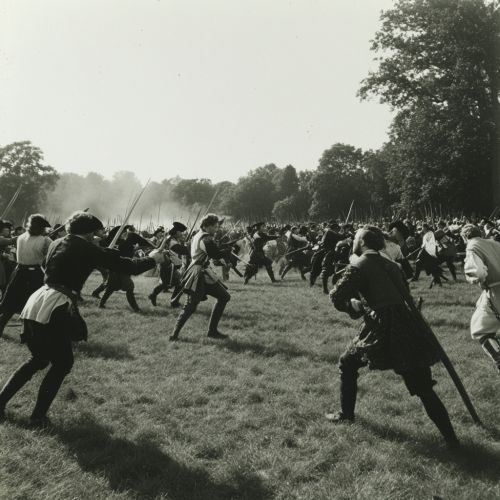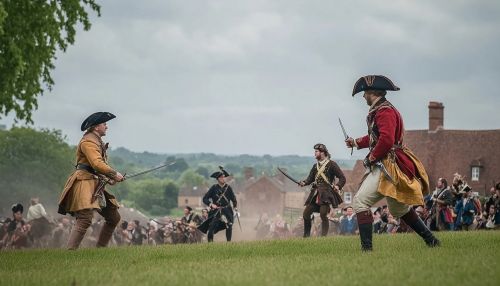Battle of St Albans: Difference between revisions
(Created page with "== Background == The Battle of St Albans, fought on May 22, 1455, marked the beginning of the Wars of the Roses, a series of dynastic conflicts that would plague England for over three decades. This battle was the first major engagement between the forces of the House of Lancaster and the House of York, two rival branches of the Plantagenet dynasty. The conflict was rooted in disputes over the English throne, exacerbated by political instability, economi...") |
No edit summary |
||
| Line 17: | Line 17: | ||
The Lancastrians, caught off guard by the Yorkist breakthrough, struggled to regroup. Somerset, commanding the Lancastrian forces, attempted to rally his troops but was ultimately overwhelmed. The battle quickly turned in favor of the Yorkists, who captured Henry VI, effectively ending the engagement. | The Lancastrians, caught off guard by the Yorkist breakthrough, struggled to regroup. Somerset, commanding the Lancastrian forces, attempted to rally his troops but was ultimately overwhelmed. The battle quickly turned in favor of the Yorkists, who captured Henry VI, effectively ending the engagement. | ||
[[Image:Detail-99471.jpg|thumb|center|A historical reenactment of the Battle of St Albans, with actors in period costume engaging in combat on a grassy field.|class=only_on_mobile]] | |||
[[Image:Detail-99472.jpg|thumb|center|A historical reenactment of the Battle of St Albans, with actors in period costume engaging in combat on a grassy field.|class=only_on_desktop]] | |||
== Aftermath == | == Aftermath == | ||
Latest revision as of 10:42, 30 October 2024
Background
The Battle of St Albans, fought on May 22, 1455, marked the beginning of the Wars of the Roses, a series of dynastic conflicts that would plague England for over three decades. This battle was the first major engagement between the forces of the House of Lancaster and the House of York, two rival branches of the Plantagenet dynasty. The conflict was rooted in disputes over the English throne, exacerbated by political instability, economic distress, and social unrest.
The immediate cause of the battle was the power struggle between King Henry VI, a Lancastrian, and his cousin Richard, Duke of York, who had a strong claim to the throne. Henry VI's reign was marked by mental illness and weak leadership, which allowed powerful nobles to vie for control. Richard of York, having served as Lord Protector during Henry's bouts of insanity, sought to assert his influence and challenge the dominance of the Lancastrian faction led by Somerset.
Prelude to the Battle
In the months leading up to the battle, tensions between the Yorkists and Lancastrians escalated. Richard of York, supported by his allies, including the Earl of Warwick, amassed an army and marched towards London, ostensibly to present grievances to the king. Henry VI, advised by Somerset, gathered his forces and moved to intercept York's army at St Albans, a strategic location north of London.
The Lancastrian army, numbering around 2,000 men, fortified their position within the town, blocking the main roads with barricades. The Yorkist army, slightly larger in size, approached from the north, seeking to force a confrontation. The stage was set for a decisive clash that would shape the course of English history.
The Battle
The Battle of St Albans commenced in the early morning hours with the Yorkists launching an assault on the town's defenses. The initial attack was repelled, but the Yorkists, under the command of Warwick, found a weak point in the Lancastrian lines. Exploiting this vulnerability, they managed to penetrate the town, leading to fierce street fighting.
The Lancastrians, caught off guard by the Yorkist breakthrough, struggled to regroup. Somerset, commanding the Lancastrian forces, attempted to rally his troops but was ultimately overwhelmed. The battle quickly turned in favor of the Yorkists, who captured Henry VI, effectively ending the engagement.


Aftermath
The outcome of the Battle of St Albans had significant political ramifications. With the capture of Henry VI, Richard of York gained considerable influence, effectively becoming the de facto ruler of England. Somerset was killed during the battle, dealing a severe blow to the Lancastrian cause. The victory at St Albans emboldened the Yorkists, setting the stage for further conflicts in the Wars of the Roses.
In the immediate aftermath, Richard of York sought to consolidate his power, but the Lancastrians, led by Queen Margaret of Anjou, remained a formidable force. The battle did not resolve the underlying issues that had led to the conflict, and tensions continued to simmer, eventually leading to further battles such as the Battle of Wakefield and the Battle of Towton.
Significance
The Battle of St Albans is often regarded as the opening salvo in the Wars of the Roses. It demonstrated the volatility of the English political landscape and the fragility of Henry VI's reign. The battle also highlighted the importance of military strategy and the role of key figures such as Warwick, who would later earn the moniker "the Kingmaker" for his pivotal role in the conflict.
The engagement at St Albans set a precedent for the brutal and protracted nature of the Wars of the Roses, characterized by shifting allegiances, dynastic rivalries, and the involvement of powerful noble families. It underscored the deep divisions within English society and the challenges of maintaining stability in a kingdom beset by internal strife.
Legacy
The legacy of the Battle of St Albans extends beyond its immediate impact on the Wars of the Roses. It marked a turning point in English history, influencing the development of the monarchy and the balance of power between the crown and the nobility. The conflict ultimately led to the rise of the Tudor dynasty, which would bring about significant changes in governance and society.
The battle is commemorated in various forms, including historical reenactments, literature, and academic studies. It serves as a reminder of the complexities of medieval politics and the enduring consequences of dynastic conflicts.
